Essay on Transtheoretical Model of Change and MI Techniques
VerifiedAdded on 2022/11/07
|6
|1526
|132
Essay
AI Summary
This essay examines the application of the Transtheoretical Model of Change (TTM) and Motivational Interviewing (MI) techniques in facilitating health behavior changes. It analyzes the different stages of change within the TTM, including pre-contemplation, contemplation, determination, action, maintenance, and relapse, and how MI can be used to support individuals through these stages. The essay uses evidence-based literature to support the use of these approaches in helping individuals like Harry, a chef, modify their behaviors. It highlights the importance of tailoring interventions to the client's readiness and understanding of their issues. The analysis covers the role of the practitioner in each stage, including providing support, reframing setbacks, and developing long-term goals. The essay emphasizes the collaborative nature of TTM and MI and their effectiveness in promoting positive therapeutic outcomes.
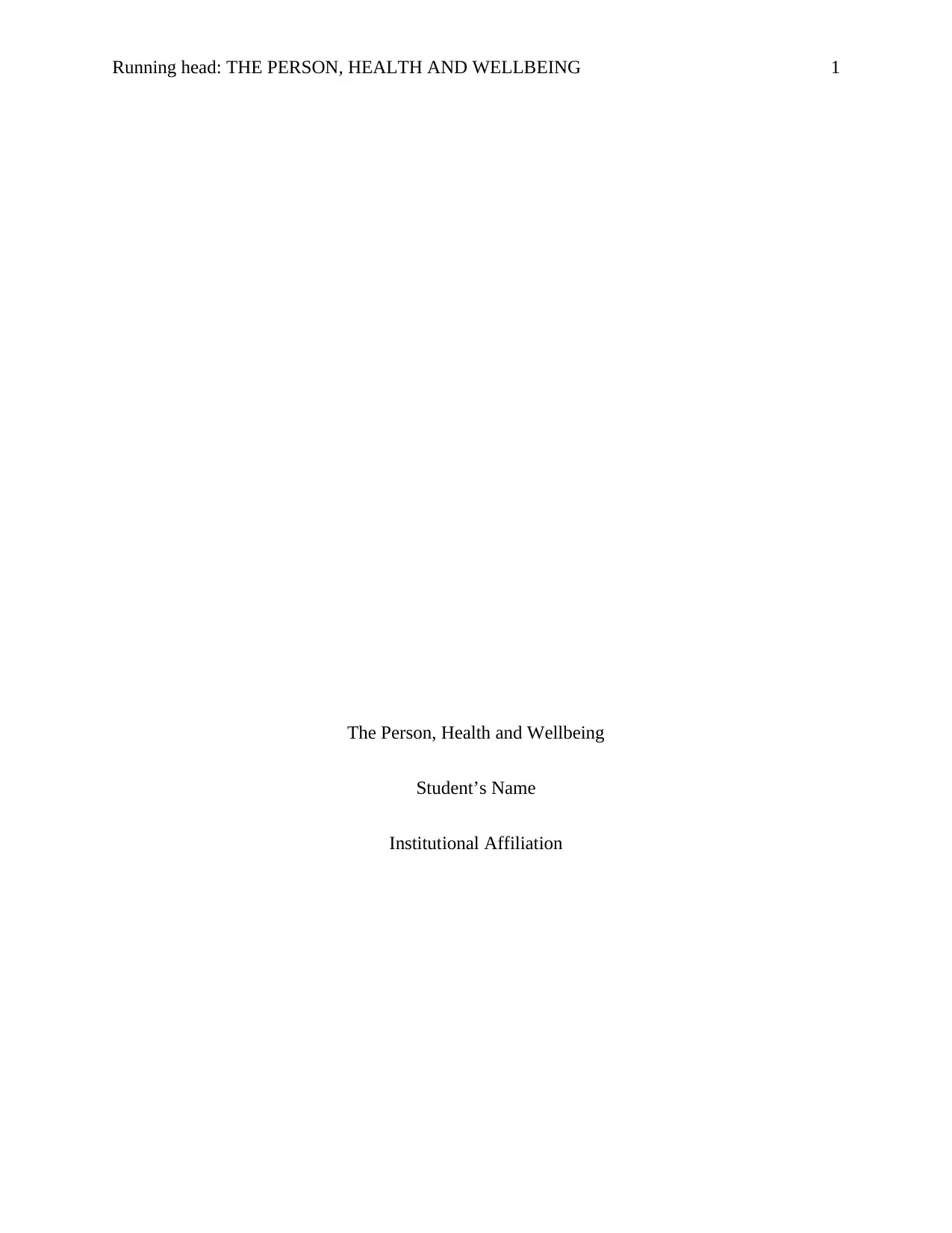
Running head: THE PERSON, HEALTH AND WELLBEING 1
The Person, Health and Wellbeing
Student’s Name
Institutional Affiliation
The Person, Health and Wellbeing
Student’s Name
Institutional Affiliation
Paraphrase This Document
Need a fresh take? Get an instant paraphrase of this document with our AI Paraphraser
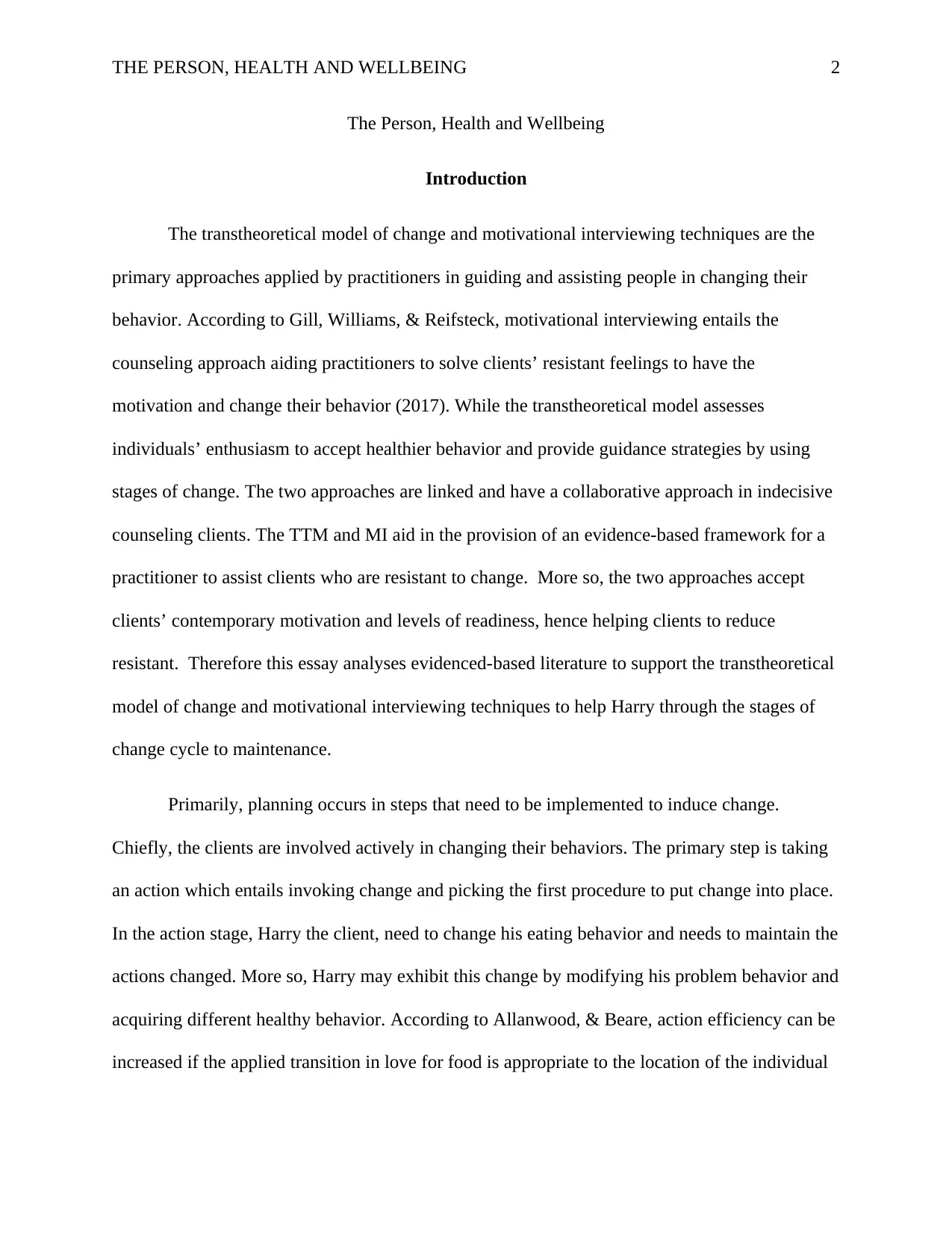
THE PERSON, HEALTH AND WELLBEING 2
The Person, Health and Wellbeing
Introduction
The transtheoretical model of change and motivational interviewing techniques are the
primary approaches applied by practitioners in guiding and assisting people in changing their
behavior. According to Gill, Williams, & Reifsteck, motivational interviewing entails the
counseling approach aiding practitioners to solve clients’ resistant feelings to have the
motivation and change their behavior (2017). While the transtheoretical model assesses
individuals’ enthusiasm to accept healthier behavior and provide guidance strategies by using
stages of change. The two approaches are linked and have a collaborative approach in indecisive
counseling clients. The TTM and MI aid in the provision of an evidence-based framework for a
practitioner to assist clients who are resistant to change. More so, the two approaches accept
clients’ contemporary motivation and levels of readiness, hence helping clients to reduce
resistant. Therefore this essay analyses evidenced-based literature to support the transtheoretical
model of change and motivational interviewing techniques to help Harry through the stages of
change cycle to maintenance.
Primarily, planning occurs in steps that need to be implemented to induce change.
Chiefly, the clients are involved actively in changing their behaviors. The primary step is taking
an action which entails invoking change and picking the first procedure to put change into place.
In the action stage, Harry the client, need to change his eating behavior and needs to maintain the
actions changed. More so, Harry may exhibit this change by modifying his problem behavior and
acquiring different healthy behavior. According to Allanwood, & Beare, action efficiency can be
increased if the applied transition in love for food is appropriate to the location of the individual
The Person, Health and Wellbeing
Introduction
The transtheoretical model of change and motivational interviewing techniques are the
primary approaches applied by practitioners in guiding and assisting people in changing their
behavior. According to Gill, Williams, & Reifsteck, motivational interviewing entails the
counseling approach aiding practitioners to solve clients’ resistant feelings to have the
motivation and change their behavior (2017). While the transtheoretical model assesses
individuals’ enthusiasm to accept healthier behavior and provide guidance strategies by using
stages of change. The two approaches are linked and have a collaborative approach in indecisive
counseling clients. The TTM and MI aid in the provision of an evidence-based framework for a
practitioner to assist clients who are resistant to change. More so, the two approaches accept
clients’ contemporary motivation and levels of readiness, hence helping clients to reduce
resistant. Therefore this essay analyses evidenced-based literature to support the transtheoretical
model of change and motivational interviewing techniques to help Harry through the stages of
change cycle to maintenance.
Primarily, planning occurs in steps that need to be implemented to induce change.
Chiefly, the clients are involved actively in changing their behaviors. The primary step is taking
an action which entails invoking change and picking the first procedure to put change into place.
In the action stage, Harry the client, need to change his eating behavior and needs to maintain the
actions changed. More so, Harry may exhibit this change by modifying his problem behavior and
acquiring different healthy behavior. According to Allanwood, & Beare, action efficiency can be
increased if the applied transition in love for food is appropriate to the location of the individual
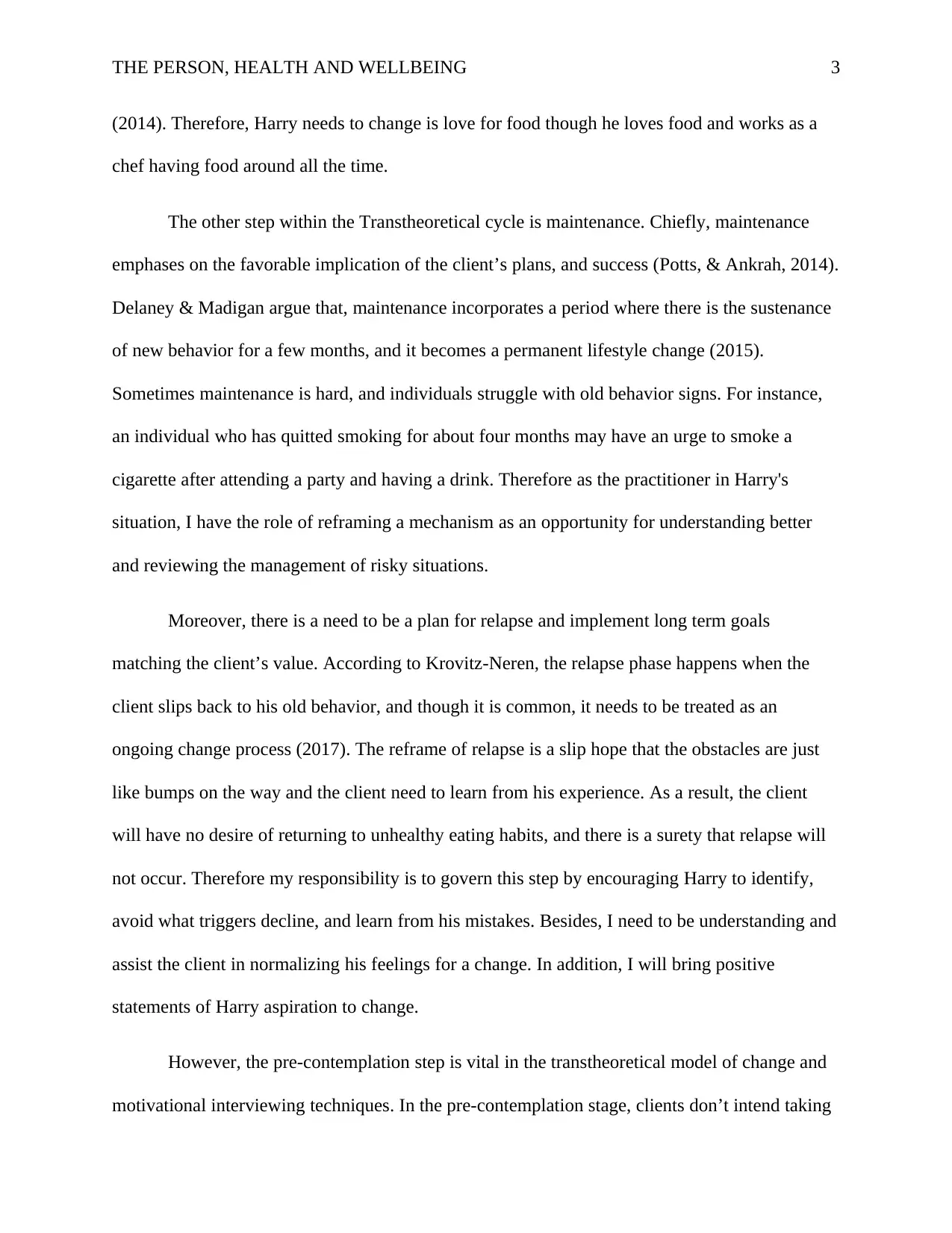
THE PERSON, HEALTH AND WELLBEING 3
(2014). Therefore, Harry needs to change is love for food though he loves food and works as a
chef having food around all the time.
The other step within the Transtheoretical cycle is maintenance. Chiefly, maintenance
emphases on the favorable implication of the client’s plans, and success (Potts, & Ankrah, 2014).
Delaney & Madigan argue that, maintenance incorporates a period where there is the sustenance
of new behavior for a few months, and it becomes a permanent lifestyle change (2015).
Sometimes maintenance is hard, and individuals struggle with old behavior signs. For instance,
an individual who has quitted smoking for about four months may have an urge to smoke a
cigarette after attending a party and having a drink. Therefore as the practitioner in Harry's
situation, I have the role of reframing a mechanism as an opportunity for understanding better
and reviewing the management of risky situations.
Moreover, there is a need to be a plan for relapse and implement long term goals
matching the client’s value. According to Krovitz-Neren, the relapse phase happens when the
client slips back to his old behavior, and though it is common, it needs to be treated as an
ongoing change process (2017). The reframe of relapse is a slip hope that the obstacles are just
like bumps on the way and the client need to learn from his experience. As a result, the client
will have no desire of returning to unhealthy eating habits, and there is a surety that relapse will
not occur. Therefore my responsibility is to govern this step by encouraging Harry to identify,
avoid what triggers decline, and learn from his mistakes. Besides, I need to be understanding and
assist the client in normalizing his feelings for a change. In addition, I will bring positive
statements of Harry aspiration to change.
However, the pre-contemplation step is vital in the transtheoretical model of change and
motivational interviewing techniques. In the pre-contemplation stage, clients don’t intend taking
(2014). Therefore, Harry needs to change is love for food though he loves food and works as a
chef having food around all the time.
The other step within the Transtheoretical cycle is maintenance. Chiefly, maintenance
emphases on the favorable implication of the client’s plans, and success (Potts, & Ankrah, 2014).
Delaney & Madigan argue that, maintenance incorporates a period where there is the sustenance
of new behavior for a few months, and it becomes a permanent lifestyle change (2015).
Sometimes maintenance is hard, and individuals struggle with old behavior signs. For instance,
an individual who has quitted smoking for about four months may have an urge to smoke a
cigarette after attending a party and having a drink. Therefore as the practitioner in Harry's
situation, I have the role of reframing a mechanism as an opportunity for understanding better
and reviewing the management of risky situations.
Moreover, there is a need to be a plan for relapse and implement long term goals
matching the client’s value. According to Krovitz-Neren, the relapse phase happens when the
client slips back to his old behavior, and though it is common, it needs to be treated as an
ongoing change process (2017). The reframe of relapse is a slip hope that the obstacles are just
like bumps on the way and the client need to learn from his experience. As a result, the client
will have no desire of returning to unhealthy eating habits, and there is a surety that relapse will
not occur. Therefore my responsibility is to govern this step by encouraging Harry to identify,
avoid what triggers decline, and learn from his mistakes. Besides, I need to be understanding and
assist the client in normalizing his feelings for a change. In addition, I will bring positive
statements of Harry aspiration to change.
However, the pre-contemplation step is vital in the transtheoretical model of change and
motivational interviewing techniques. In the pre-contemplation stage, clients don’t intend taking
⊘ This is a preview!⊘
Do you want full access?
Subscribe today to unlock all pages.

Trusted by 1+ million students worldwide
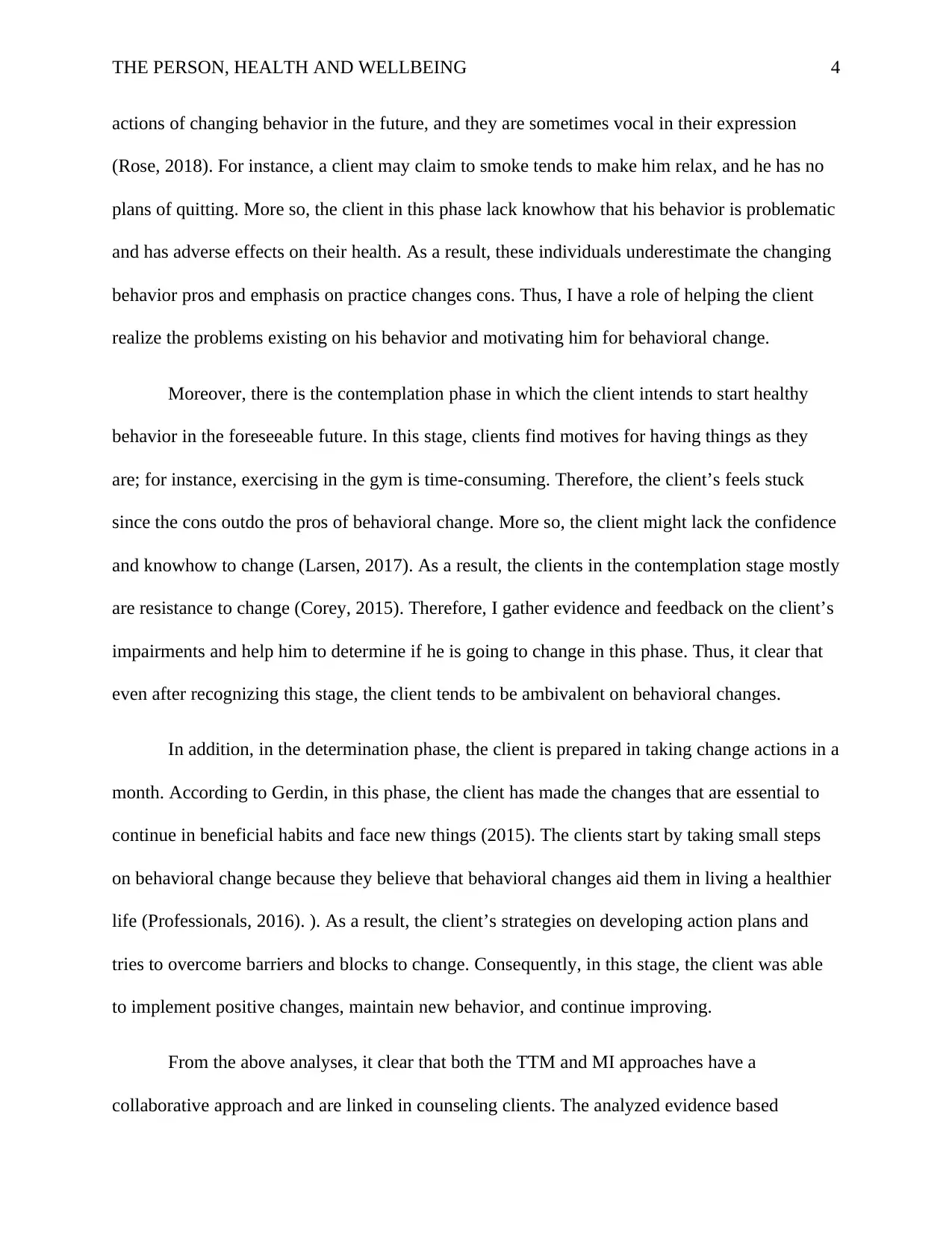
THE PERSON, HEALTH AND WELLBEING 4
actions of changing behavior in the future, and they are sometimes vocal in their expression
(Rose, 2018). For instance, a client may claim to smoke tends to make him relax, and he has no
plans of quitting. More so, the client in this phase lack knowhow that his behavior is problematic
and has adverse effects on their health. As a result, these individuals underestimate the changing
behavior pros and emphasis on practice changes cons. Thus, I have a role of helping the client
realize the problems existing on his behavior and motivating him for behavioral change.
Moreover, there is the contemplation phase in which the client intends to start healthy
behavior in the foreseeable future. In this stage, clients find motives for having things as they
are; for instance, exercising in the gym is time-consuming. Therefore, the client’s feels stuck
since the cons outdo the pros of behavioral change. More so, the client might lack the confidence
and knowhow to change (Larsen, 2017). As a result, the clients in the contemplation stage mostly
are resistance to change (Corey, 2015). Therefore, I gather evidence and feedback on the client’s
impairments and help him to determine if he is going to change in this phase. Thus, it clear that
even after recognizing this stage, the client tends to be ambivalent on behavioral changes.
In addition, in the determination phase, the client is prepared in taking change actions in a
month. According to Gerdin, in this phase, the client has made the changes that are essential to
continue in beneficial habits and face new things (2015). The clients start by taking small steps
on behavioral change because they believe that behavioral changes aid them in living a healthier
life (Professionals, 2016). ). As a result, the client’s strategies on developing action plans and
tries to overcome barriers and blocks to change. Consequently, in this stage, the client was able
to implement positive changes, maintain new behavior, and continue improving.
From the above analyses, it clear that both the TTM and MI approaches have a
collaborative approach and are linked in counseling clients. The analyzed evidence based
actions of changing behavior in the future, and they are sometimes vocal in their expression
(Rose, 2018). For instance, a client may claim to smoke tends to make him relax, and he has no
plans of quitting. More so, the client in this phase lack knowhow that his behavior is problematic
and has adverse effects on their health. As a result, these individuals underestimate the changing
behavior pros and emphasis on practice changes cons. Thus, I have a role of helping the client
realize the problems existing on his behavior and motivating him for behavioral change.
Moreover, there is the contemplation phase in which the client intends to start healthy
behavior in the foreseeable future. In this stage, clients find motives for having things as they
are; for instance, exercising in the gym is time-consuming. Therefore, the client’s feels stuck
since the cons outdo the pros of behavioral change. More so, the client might lack the confidence
and knowhow to change (Larsen, 2017). As a result, the clients in the contemplation stage mostly
are resistance to change (Corey, 2015). Therefore, I gather evidence and feedback on the client’s
impairments and help him to determine if he is going to change in this phase. Thus, it clear that
even after recognizing this stage, the client tends to be ambivalent on behavioral changes.
In addition, in the determination phase, the client is prepared in taking change actions in a
month. According to Gerdin, in this phase, the client has made the changes that are essential to
continue in beneficial habits and face new things (2015). The clients start by taking small steps
on behavioral change because they believe that behavioral changes aid them in living a healthier
life (Professionals, 2016). ). As a result, the client’s strategies on developing action plans and
tries to overcome barriers and blocks to change. Consequently, in this stage, the client was able
to implement positive changes, maintain new behavior, and continue improving.
From the above analyses, it clear that both the TTM and MI approaches have a
collaborative approach and are linked in counseling clients. The analyzed evidence based
Paraphrase This Document
Need a fresh take? Get an instant paraphrase of this document with our AI Paraphraser
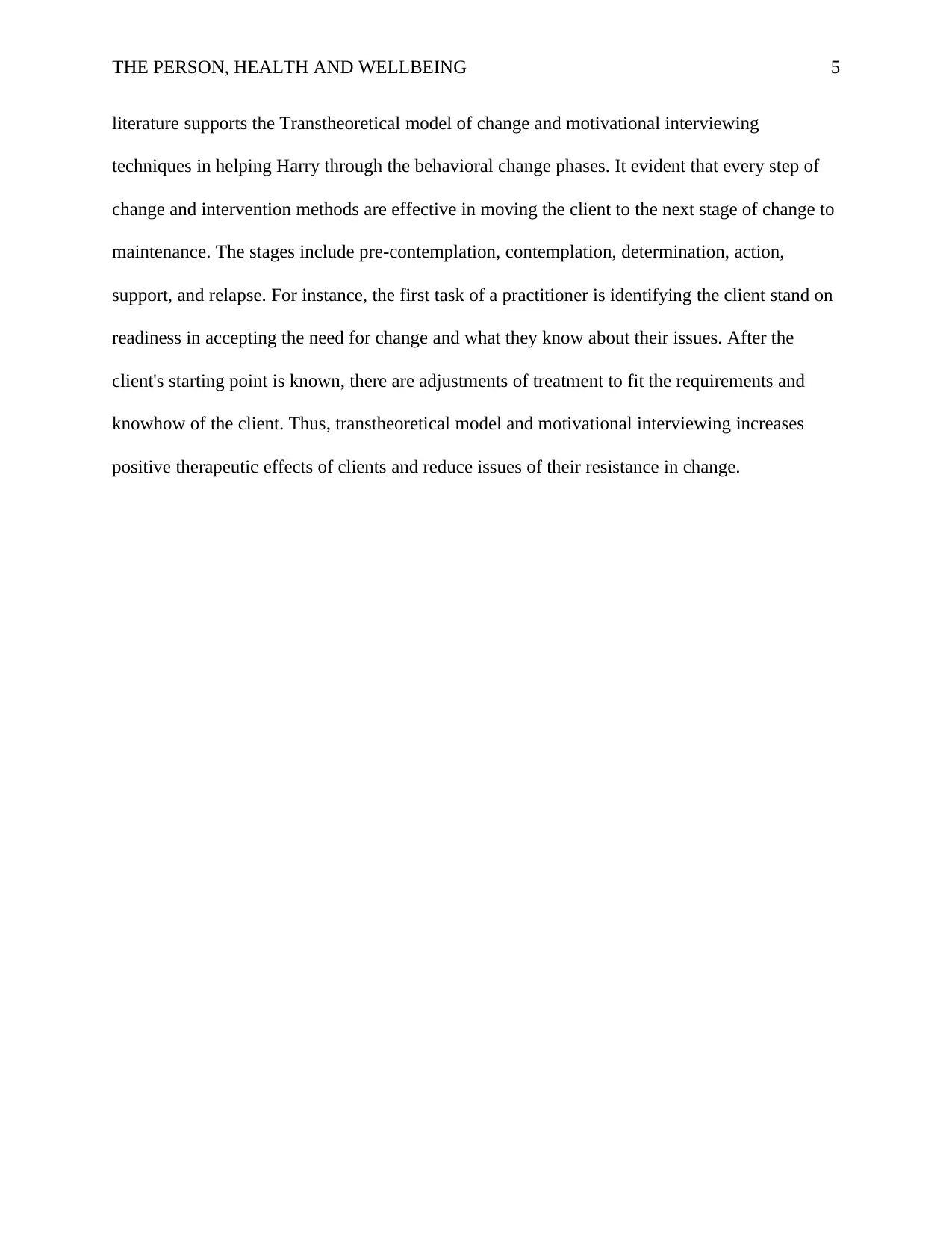
THE PERSON, HEALTH AND WELLBEING 5
literature supports the Transtheoretical model of change and motivational interviewing
techniques in helping Harry through the behavioral change phases. It evident that every step of
change and intervention methods are effective in moving the client to the next stage of change to
maintenance. The stages include pre-contemplation, contemplation, determination, action,
support, and relapse. For instance, the first task of a practitioner is identifying the client stand on
readiness in accepting the need for change and what they know about their issues. After the
client's starting point is known, there are adjustments of treatment to fit the requirements and
knowhow of the client. Thus, transtheoretical model and motivational interviewing increases
positive therapeutic effects of clients and reduce issues of their resistance in change.
literature supports the Transtheoretical model of change and motivational interviewing
techniques in helping Harry through the behavioral change phases. It evident that every step of
change and intervention methods are effective in moving the client to the next stage of change to
maintenance. The stages include pre-contemplation, contemplation, determination, action,
support, and relapse. For instance, the first task of a practitioner is identifying the client stand on
readiness in accepting the need for change and what they know about their issues. After the
client's starting point is known, there are adjustments of treatment to fit the requirements and
knowhow of the client. Thus, transtheoretical model and motivational interviewing increases
positive therapeutic effects of clients and reduce issues of their resistance in change.
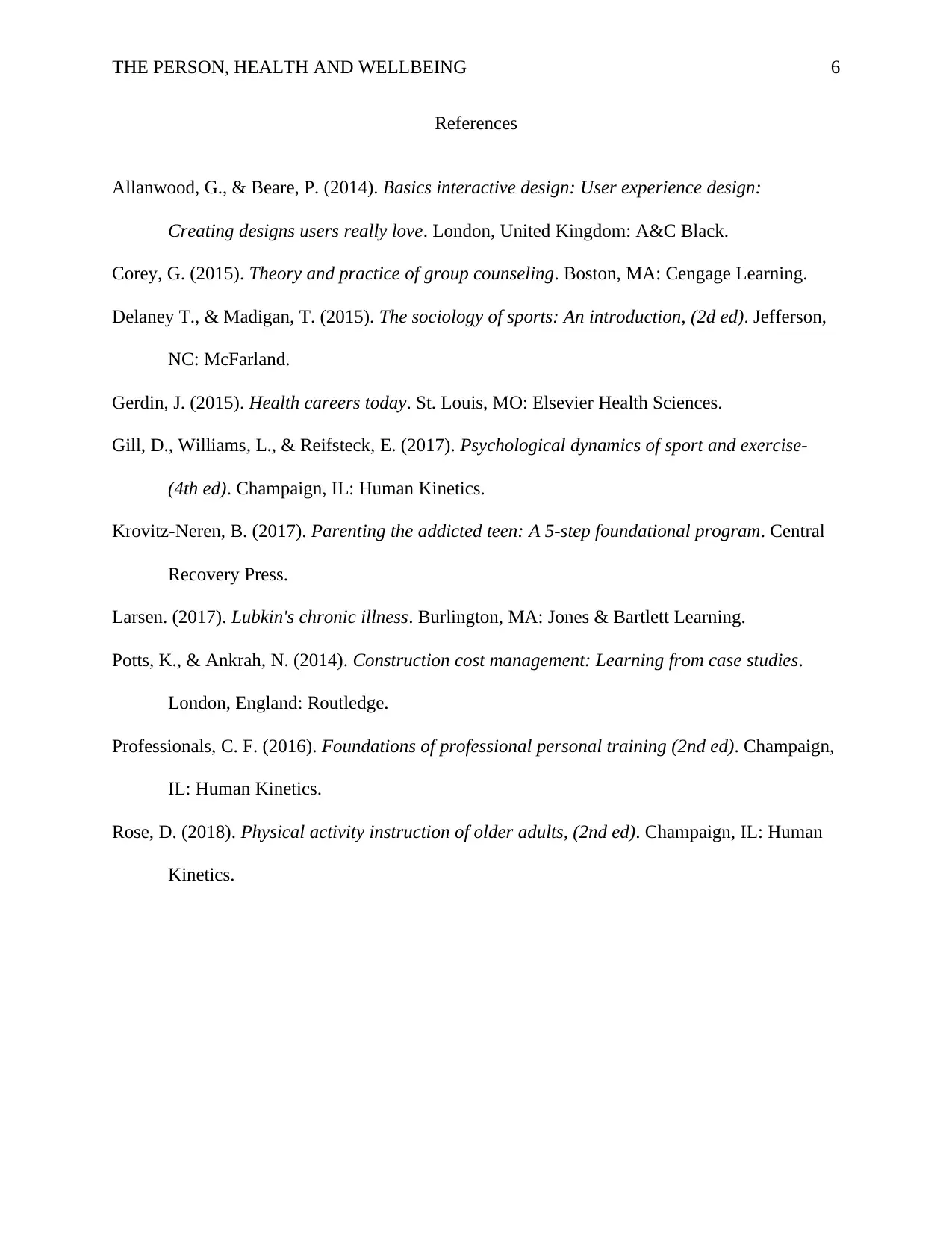
THE PERSON, HEALTH AND WELLBEING 6
References
Allanwood, G., & Beare, P. (2014). Basics interactive design: User experience design:
Creating designs users really love. London, United Kingdom: A&C Black.
Corey, G. (2015). Theory and practice of group counseling. Boston, MA: Cengage Learning.
Delaney T., & Madigan, T. (2015). The sociology of sports: An introduction, (2d ed). Jefferson,
NC: McFarland.
Gerdin, J. (2015). Health careers today. St. Louis, MO: Elsevier Health Sciences.
Gill, D., Williams, L., & Reifsteck, E. (2017). Psychological dynamics of sport and exercise-
(4th ed). Champaign, IL: Human Kinetics.
Krovitz-Neren, B. (2017). Parenting the addicted teen: A 5-step foundational program. Central
Recovery Press.
Larsen. (2017). Lubkin's chronic illness. Burlington, MA: Jones & Bartlett Learning.
Potts, K., & Ankrah, N. (2014). Construction cost management: Learning from case studies.
London, England: Routledge.
Professionals, C. F. (2016). Foundations of professional personal training (2nd ed). Champaign,
IL: Human Kinetics.
Rose, D. (2018). Physical activity instruction of older adults, (2nd ed). Champaign, IL: Human
Kinetics.
References
Allanwood, G., & Beare, P. (2014). Basics interactive design: User experience design:
Creating designs users really love. London, United Kingdom: A&C Black.
Corey, G. (2015). Theory and practice of group counseling. Boston, MA: Cengage Learning.
Delaney T., & Madigan, T. (2015). The sociology of sports: An introduction, (2d ed). Jefferson,
NC: McFarland.
Gerdin, J. (2015). Health careers today. St. Louis, MO: Elsevier Health Sciences.
Gill, D., Williams, L., & Reifsteck, E. (2017). Psychological dynamics of sport and exercise-
(4th ed). Champaign, IL: Human Kinetics.
Krovitz-Neren, B. (2017). Parenting the addicted teen: A 5-step foundational program. Central
Recovery Press.
Larsen. (2017). Lubkin's chronic illness. Burlington, MA: Jones & Bartlett Learning.
Potts, K., & Ankrah, N. (2014). Construction cost management: Learning from case studies.
London, England: Routledge.
Professionals, C. F. (2016). Foundations of professional personal training (2nd ed). Champaign,
IL: Human Kinetics.
Rose, D. (2018). Physical activity instruction of older adults, (2nd ed). Champaign, IL: Human
Kinetics.
⊘ This is a preview!⊘
Do you want full access?
Subscribe today to unlock all pages.

Trusted by 1+ million students worldwide
1 out of 6
Related Documents
Your All-in-One AI-Powered Toolkit for Academic Success.
+13062052269
info@desklib.com
Available 24*7 on WhatsApp / Email
![[object Object]](/_next/static/media/star-bottom.7253800d.svg)
Unlock your academic potential
Copyright © 2020–2025 A2Z Services. All Rights Reserved. Developed and managed by ZUCOL.





